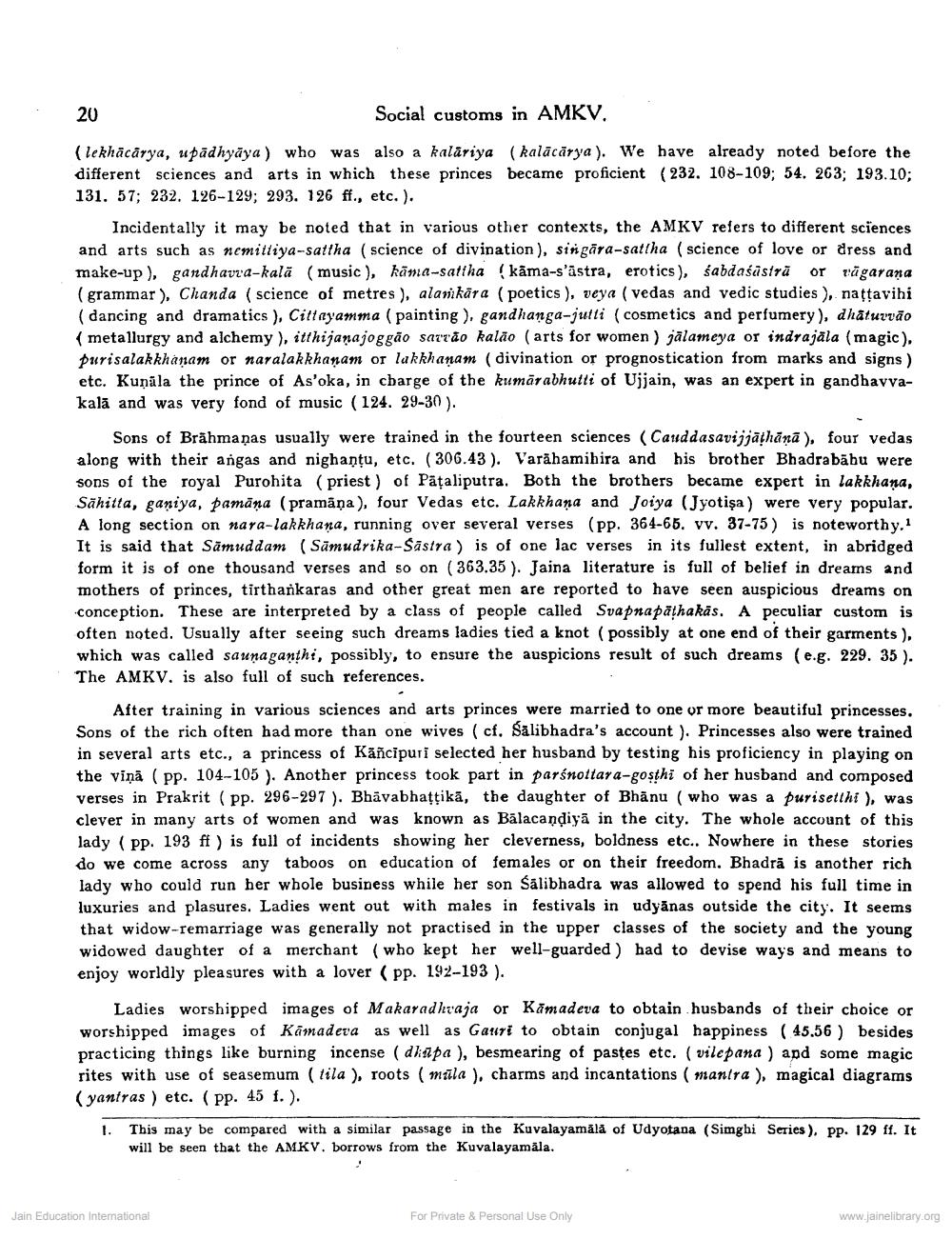________________
20
Social customs in AMKV.
(lekhācārya, upadhyāya) who was also a kaláriya (kalācārya). We have already noted before the different sciences and arts in which these princes became proficient (232, 108-109; 54. 263; 193.10; 131. 57; 232. 126-129; 293. 126 ff., etc.).
Incidentally it may be noted that in various other contexts, the AMKV refers to different sciences and arts such as nemitliya-sattha (science of divination ), singara-sattha (science of love or dress and make-up), gandhavra-kalā (music), kāma-sattha (kāma-s'astra, erotics), sabdaśāstrā or rāgarana (grammar), Chanda (science of metres ), alarikāra (poetics ), veya ( vedas and vedic studies ), națțavihi (dancing and dramatics ), Cittayamma (painting ), gandhanga-jutli (cosmetics and perfumery), dhaturvão ( metallurgy and alchemy), itthijanajoggão sarrão kalão (arts for women) jalameya or indrajala (magic). purisalakkhanam or naralakkhanam or lakkhanam divination or prognostication from marks and signs) etc. Kuņāla the prince of As'oka, in charge of the kumārabhutti of Ujjain, was an expert in gandhavvakalā and was very fond of music ( 124. 29-30).
Sons of Brāhmaṇas usually were trained in the fourteen sciences (Cauddasavijjāthāņā ), four vedas along with their angas and nighanţu, etc. (306.43). Varāhamihira and his brother Bhadrabābu were sons of the royal Purohita ( priest) of Pataliputra. Both the brothers became expert in lakkhana, Sāhitta, ganiya, pamāna (pramāņa), four Vedas etc. Lakkhana and Joiya (Jyotişa) were very popular. A long section on nara-lakkhana, running over several verses (pp. 364-65. vv. 37-75) is noteworthy.1 It is said that Samuddam (Samudrika-Sastra ) is of one lac verses in its fullest extent, in abridged form it is of one thousand verses and so on (363.35 ). Jaina literature is full of belief in dreams and mothers of princes, tirthankaras and other great men are reported to have seen auspicious dreams on conception. These are interpreted by a class of people called Svapnapathakās. A peculiar custom is often noted. Usually after seeing such dreams ladies tied a knot possibly at one end of their garments ). which was called saunaganthi, possibly, to ensure the auspicions result of such dreams (e.g. 229. 35 ). The AMKV, is also full of such references.
After training in various sciences and arts princes were married to one or more beautiful princesses. Sons of the rich often had more than one wives (cf. Salibhadra's account ). Princesses also were trained in several arts etc., a princess of Kāñcīpuri selected her husband by testing his proficiency in playing on the viņā (pp. 104-105 ). Another princess took part in parśnottara-gosthi of her husband and composed verses in Prakrit (pp. 296-297). Bhāvabhațţikā, the daughter of Bhānu (who was a purisetthi ), was clever in many arts of women and was known as Bālacandiya in the city. The whole account of this lady (pp. 193 ff) is full of incidents showing her cleverness, boldness etc.. Nowhere in these stories do we come across any taboos on education of females or on their freedom. Bhadra is another rich lady who could run her whole business while her son Salibhadra was allowed to spend his full time in luxuries and plasures. Ladies went out with males in festivals in udyānas outside the city. It seems that widow-remarriage was generally not practised in the upper classes of the society and the young widowed daughter of a merchant (who kept her well-guarded ) had to devise ways and means to enjoy worldly pleasures with a lover (pp. 192-193 ).
Ladies worshipped images of Makaradhtaja or Kamadeva to obtain husbands of their choice or worshipped images of Kamadeva as well as Gauri to obtain conjugal happiness ( 45.56 ) besides practicing things like burning incense (dlapa ), besmearing of pastes etc. (vilepana ) apd some magic rites with use of seasemum (tila ), roots ( mula ), charms and incantations ( mantra ), magical diagrams (yantras ) etc. (pp. 45 f.).
1.
This may be compared with a similar passage in the Kuvalayamálă of Udyotana (Simghi Series), pp. 129 ff. It will be seen that the AMKV. borrows from the Kuvalayamala.
Jain Education International
For Private & Personal Use Only
www.jainelibrary.org




